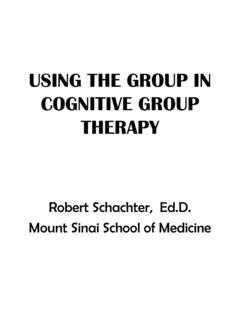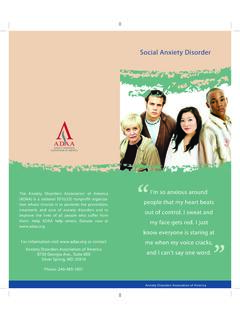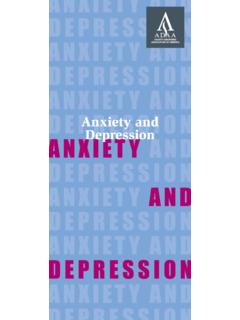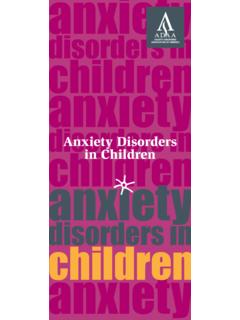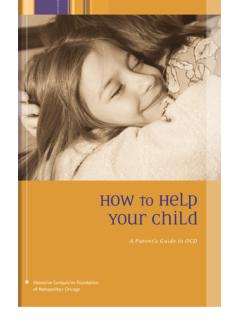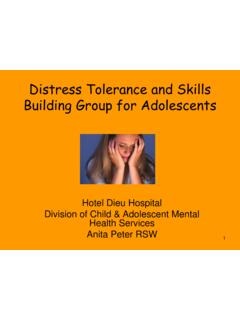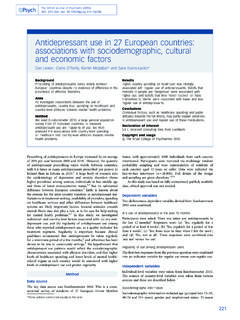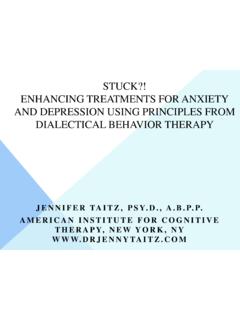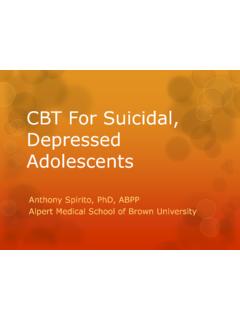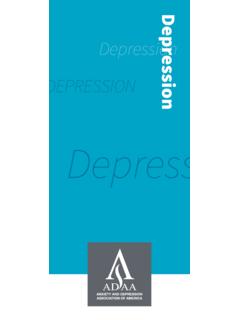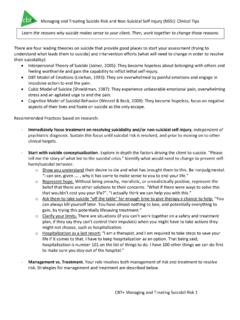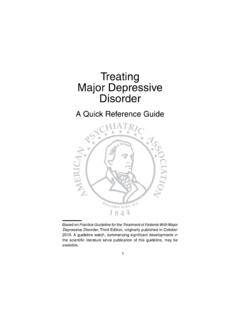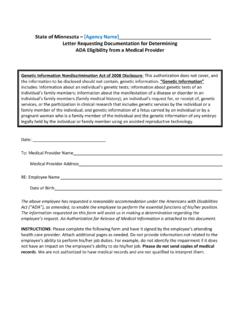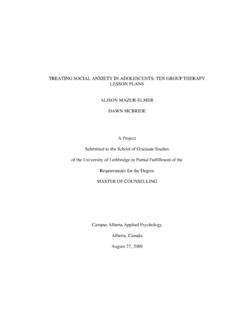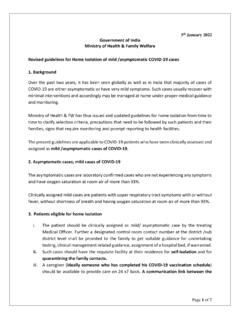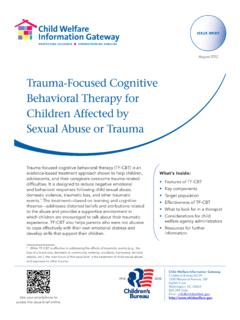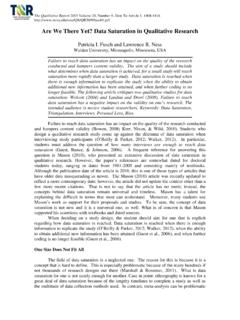Transcription of Treating Anxiety Disorders
1 Treating Anxiety DisordersAbout Anxiety DisorDersAnxiety is a normal part of living. It s a biological reaction the body s way of telling us something isn t right. It keeps us from harm s way and prepares us to act quickly in the face of danger. However, for some people, Anxiety is persistent, irrational, and overwhelming. It may interfere with daily activities and even make them impossible. This may be a sign of an Anxiety term Anxiety Disorders describes this group of conditions:generalized Anxiety disorder (GAD): persistent, excessive, and unrealistic worry about everyday thingsobsessive-compulsive disorder (OCD): unwanted and intrusive thoughts (obsessions) and ritualistic behaviors and routines (compulsions) conducted to ease anxietypanic disorder: spontaneous, seemingly out-of-the-blue panic or Anxiety attacks and the preoccupation with the fear of a recurring attackposttraumatic stress disorder (PTSD): an Anxiety disorder triggered by an extremely traumatic event in which grave physical harm occurred or was threatened or witnessedsocial Anxiety disorder (social phobia): an intense fear of being scrutinized and negatively evaluated by others in social or performance situationsspecific phobias.
2 Seemingly excessive and unreasonable fears in the presence of or in anticipation of a specific object, place, or situation More than 40 million adults in the United States over the age of 18 suffer from at least one Anxiety disorder, and Anxiety Disorders are the most common mental health illness in children. Researchers are learning that Anxiety Disorders run in families, and that they have a biological basis, much like allergies or diabetes and other you think you or a loved one might have an Anxiety disorder, read this booklet about treatment. For more information about Anxiety Disorders , visit AnD Anxiety -relAteD DisorDersIt s not uncommon for people with an Anxiety disorder to suffer from numerous mental health Disorders such as depression, bipolar disorder, alcohol abuse, and sleep Disorders , as well as from irritable bowel syndrome, fibromyalgia, and other physical Disorders .
3 Some people may have a primary disorder, which requires that it be treated first. For example, if someone with social Anxiety disorder is depressed about the inability to socialize with friends and family , the Anxiety disorder may be triggering the depression, and it would be addressed first. Or if a person with depression is unable to begin treatment for an Anxiety disorder, which requires high motivation and energy, it may be necessary to treat the depression first. Anxiety Disorders Are reAl, serious, AnDtreAtAble23 Choosing treAtment for Anxiety DisorDersSafe and effective treatments are available. Which treatment is best? is the most commonly asked question. Here s the answer: Consult a doctor or therapist to get a proper diagnosis and to learn about treatment options, length of treatment, side effects, time commitment, and other health issues to help you decide on the best treatment approach for you.
4 Treatments may include medication or therapy; both types have been found effective. A combination of medication and therapy may also be effective. The decision about treatment is based on your needs and preferences and should be discussed with a professional who is familiar with your diagnosis and overall health. Most people with an Anxiety disorder can be helped with professional care. Success of treatment varies; some may respond to treatment after a few months, while others may need longer. Treatment may be complicated for those with more than one Anxiety disorder or suffering from co-existing conditions such as depression or diabetes. This is why treatment must be tailored to each ChilDren AnD teens Children and teens have Anxiety in their lives, and like adults, they can suffer from Anxiety Disorders . Starting school, moving, the loss of a parent or grandparent, and other stressful events can trigger the onset of an Anxiety disorder, but an Anxiety disorder does not necessarily stem from a major event.
5 Taking your child to the doctor for Anxiety is as important as visiting the doctor for an ear infection or broken ProviDersMany kinds of health care professionals are trained to diagnose and treat Anxiety Disorders : physicians (including psychiatrists, internists, OB-GYNs, family practice), psychologists, social workers, behavioral health specialists, marriage and family therapists, nurses, nurse practitioners, and physician assistants. Clergy and school counselors may also be able to help. A layperson specialist, usually someone who has recovered from an Anxiety disorder, may also provide assistance. The cost for services and reimbursement varies depending on the type of professional, individual health insurance, and state a therapist near you at Those listed are members of the Anxiety Disorders Association of America who specialize in Anxiety Disorders . Requirements for the practice of psychotherapy vary among states.
6 Ask about a therapist s training and credentials before beginning places to contact to find a treatment provider:Health insurer Psychiatry department at a local medical school University psychology department Local hospital mental health clinics or staff psychiatrists State or local mental health agency or veterans administration (VA)Counseling services on a local college campus 5 CheCklist for Choosing treAtment Consider the following questions and issues when deciding on a mental health professional and type of and credentials. Consider the training of the professional and inquire about experience or expertise with the disorder. If the professional is licensed in your state or a preferred provider for your health insurer, make sure he or she has the appropriate training and Select professionals who have experience Treating Anxiety Disorders . Ask about their basic approach to involvement.
7 Find out the role family members play in treatment. Make sure you understand how loved ones are involved and are comfortable with it. Type and format of treatment. Make sure you understand the course of treatment, including length, procedures, frequency and duration of the sessions, and expected length of time any medication will be and insurance. Know your health insurance coverage for mental health, and ask if your insurance is accepted. It s your responsibility to know your financial resources and any insurance requirements and limitations. Find out if the fee schedule is on a sliding scale based on and confidence. It is important to feel comfortable with a mental health professional. Having confidence in the person is essential for establishing a positive working Ask how the mental health professional will communicate with your family oPtions Most people who seek treatment experience significant improvement and an improved quality of life.
8 It is important to work closely with a health care professional to determine the best option for you. In general, treatment can involve medications, talk therapy, exposure therapy, support groups, and self-help. Therapists will use one or a combination of these note: New treatments medications and therapies for Anxiety and Anxiety -related Disorders are being tested all the time. Check for updated Cognitive-behavioral therapy, or CBT, is a well-established, highly effective, and lasting treatment. It focuses on understanding and changing thinking and behavior patterns. Benefits are usually seen in 12 to 16 weeks, depending on the individual. CBT typically involves reading about the problem, keeping records between appointments, and completing homework assignments in which the treatment procedures are prac-ticed. Patients learn skills during therapy sessions, but they must practice repeatedly to see improvement.
9 In this type of therapy the patient is actively involved in his or her own recovery, has a sense of control, and learns skills that are useful throughout therapy, a form of CBT, is a process for reducing fear and Anxiety responses. In therapy, a person is gradually exposed to a feared situation or object, learning to become less sensitive over time. Although the first line of treatment for an Anxiety disorder is often CBT, some people find that excessively high levels of Anxiety make them unable to get the most out of such treatment. In this case, a combination of treatments, using CBT and medication may be recommended. Acceptance and Commitment Therapy, or ACT, uses strategies of acceptance and mindfulness (living in the moment and experiencing things without judgment), along with commitment and behavior change, as a way to cope with unwanted thoughts, feelings, and sensations.
10 ACT imparts skills to accept these experiences, place them in a different 7meDiCAtion WArning for ChilDren The Food and Drug Administration (FDA) issued a warning in October 2004 that antidepressant medica-tions, including SSRIs, may increase suicidal thoughts and behavior in a small number of children and ado-lescents. The FDA does not prohibit the use of these medications, but it does alert patients and families to the risks, which must be balanced against clinical need. In May 2007, the FDA proposed that makers of all antide-pressant medications update their products labeling to include warnings about increased risks of suicidal think-ing and behavior in young adults ages 18 to 24 during initial treatment (generally the first one to two months). Find out more at the FDA website: all concerns about antidepressants and other medications with your meDiCAtions: WhAt you neeD to knoWUse these guidelines to talk to your health care professional about medications:To avoid potentially dangerous drug interactions, let your doctor or therapist know all medications you are taking, including prescriptions and over-the-counter drugs, herbal or dietary supplements, and vitamins.
